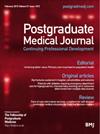CT 上的瘤内钙化有助于区分良性和恶性上腹部肿瘤。
IF 3.6
4区 医学
Q1 MEDICINE, GENERAL & INTERNAL
引用次数: 0
摘要
背景钙化和微钙化在诊断恶性肿瘤中的意义已得到公认,但在常规放射学中,它们在上腹部的作用却较少被探讨。目的评估计算机断层扫描(CT)成像在检测上腹部肿瘤瘤内钙化中的有效性。方法本研究回顾性地纳入了2016年1月至2019年12月期间接受普通和对比增强CT扫描的上腹部肿瘤患者,这些患者均具有瘤内钙化特征。我们研究了钙化的成像特征,包括位置、边缘、形状、CT 值以及与坏死的关联。我们使用接收器操作特征曲线评估了钙化对区分良性肿瘤和恶性肿瘤的诊断效用。该研究纳入了 153 例经病理证实为上腹部(包括肝脏、胰腺和胃肠道)肿瘤并伴有瘤内钙化的患者(中位年龄 49 ± 21 岁;83 例男性)。良性肿瘤和恶性肿瘤的CT值存在显著差异(P < .001),CT成像对钙化的诊断准确性很高(接收器操作特征区 = 0.884,灵敏度 = 0.815,特异性 = 0.976)。钙化的特征,包括其边缘和形状,与肿瘤分化有显著相关性(P < .01)。多变量逻辑回归分析显示,钙化周围存在邻近坏死是恶性肿瘤的独立预测因素(几率比 = 5.48;95% 置信区间:1.55, 19.41;P = .008)。关键信息--关于该主题的已知信息--瘤内钙化作为一种高度敏感的放射学标志物,在区分甲状腺癌和乳腺癌的良恶性肿瘤方面已显示出潜力。然而,它在上腹部肿瘤中的鉴别作用却常常被忽视。因此,评估 CT 扫描中瘤内钙化的诊断准确性对于提高诊断效率和避免不必要的检查至关重要。- 本研究的意义 - CT上的瘤内钙化在区分良性和恶性上腹部肿瘤方面具有很高的特异性,为提高诊断准确性提供了一个简单可靠的标准。- 本研究对研究、实践或政策有何影响 - 本研究强调了在 CT 上观察到的瘤内钙化特征在确定上腹部肿瘤是良性还是恶性方面的重要意义。研究结果可为开发基于 CT 的钙化评分系统铺平道路,这将有助于在临床实践中进行快速准确的诊断,从而优化治疗策略并改善患者预后。本文章由计算机程序翻译,如有差异,请以英文原文为准。
Intratumoral calcification on CT assists in distinguishing benign and malignant upper abdomen neoplasm.
BACKGROUND
The significance of calcification and microcalcification in diagnosing malignant tumors is well established, but their role in the upper abdomen is less explored in routine radiology.
OBJECTIVES
To assess the effectiveness of computed tomography (CT) imaging in detecting intratumoral calcification within upper abdominal tumors.
METHODS
This study retrospectively enrolled patients with upper abdominal tumors featuring intratumoral calcifications who underwent plain and contrast-enhanced CT scans between January 2016 and December 2019. We examined the imaging characteristics of calcifications, including location, edges, shape, CT values, and association with necrosis. The diagnostic utility of calcification for distinguishing benign and malignant tumors was assessed using receiver operating characteristic curves. Univariate and multivariate logistic regression analyses were conducted to identify independent predictive factors for the diagnosis of malignancy characterized by intratumoral calcification.
RESULTS
This study included 153 patients (median age 49 ± 21 years; 83 men) with pathologically confirmed tumors of the upper abdomen (including liver, pancreas, and gastrointestinal tract) with intratumoral calcifications. Significant differences in CT values between benign and malignant tumors were observed (P < .001), with high diagnostic accuracy of calcification in CT imaging (receiver operating characteristic area = 0.884, sensitivity = 0.815, specificity = 0.976). The characteristics of calcification, including its edge and shape, were significantly correlated with tumor differentiation (P < .01). Multivariate logistic regression analysis revealed that the presence of adjacent necrosis around intracalcification is an independent predictor of malignancy (odds ratio = 5.48; 95% confidence interval: 1.55, 19.41; P = .008).
CONCLUSION
Intratumoral calcification in CT imaging is a key marker for distinguishing between benign and malignant epigastric tumors, offering high specificity. Key message • What is already known on this topic - Intratumoral calcification, as a highly sensitive radiological marker, has shown potential in differentiating between benign and malignant tumors in thyroid and breast cancers. However, its discriminatory role in upper abdominal tumors is often overlooked. Therefore, assessing the diagnostic accuracy of intratumoral calcification on CT scans is crucial for improving diagnostic efficiency and avoiding unnecessary examinations. • What this study adds - Intratumoral calcification on CT exhibits high specificity in differentiating between benign and malignant upper abdominal tumors, providing a simple and reliable criterion for improving diagnostic accuracy. • How this study might affect research, practice or policy - This study highlights the significance of intratumoral calcification characteristics observed on CT in determining whether upper abdominal tumors are benign or malignant. The findings could pave the way for the development of a CT-based calcification scoring system, which would facilitate rapid and accurate diagnostics in clinical practice, thereby optimizing treatment strategies and enhancing patient prognosis.
求助全文
通过发布文献求助,成功后即可免费获取论文全文。
去求助
来源期刊

Postgraduate Medical Journal
医学-医学:内科
CiteScore
8.50
自引率
2.00%
发文量
131
审稿时长
2.5 months
期刊介绍:
Postgraduate Medical Journal is a peer reviewed journal published on behalf of the Fellowship of Postgraduate Medicine. The journal aims to support junior doctors and their teachers and contribute to the continuing professional development of all doctors by publishing papers on a wide range of topics relevant to the practicing clinician and teacher. Papers published in PMJ include those that focus on core competencies; that describe current practice and new developments in all branches of medicine; that describe relevance and impact of translational research on clinical practice; that provide background relevant to examinations; and papers on medical education and medical education research. PMJ supports CPD by providing the opportunity for doctors to publish many types of articles including original clinical research; reviews; quality improvement reports; editorials, and correspondence on clinical matters.
 求助内容:
求助内容: 应助结果提醒方式:
应助结果提醒方式:


